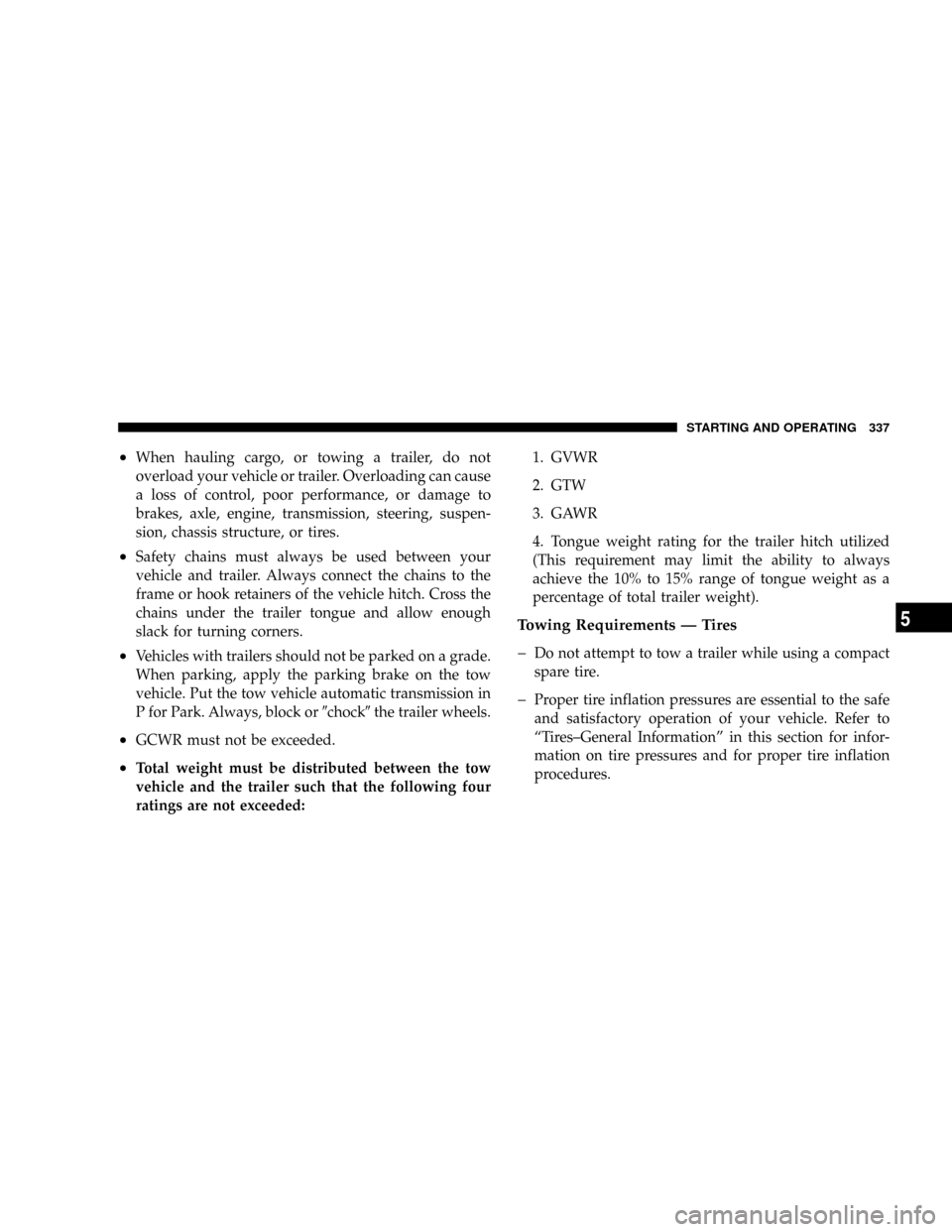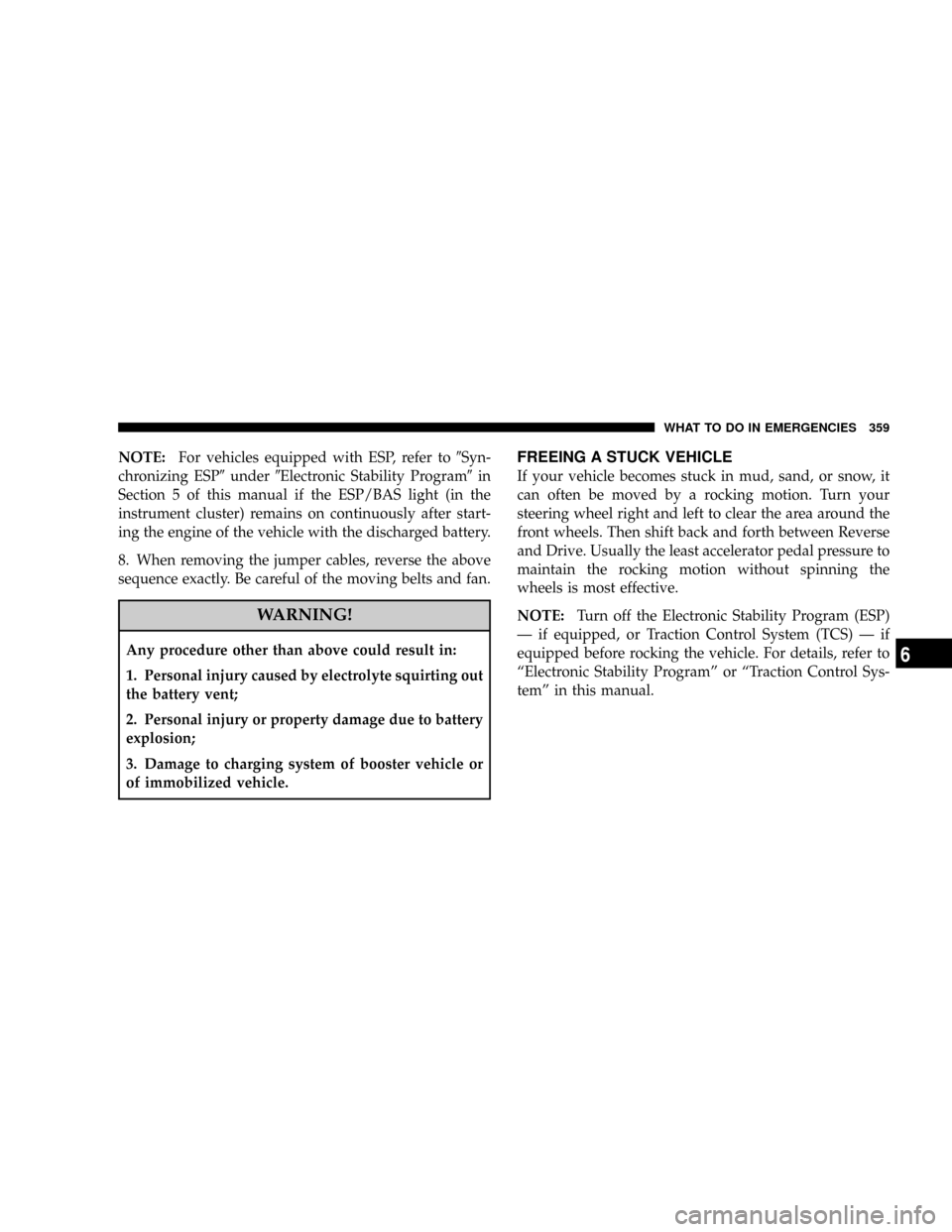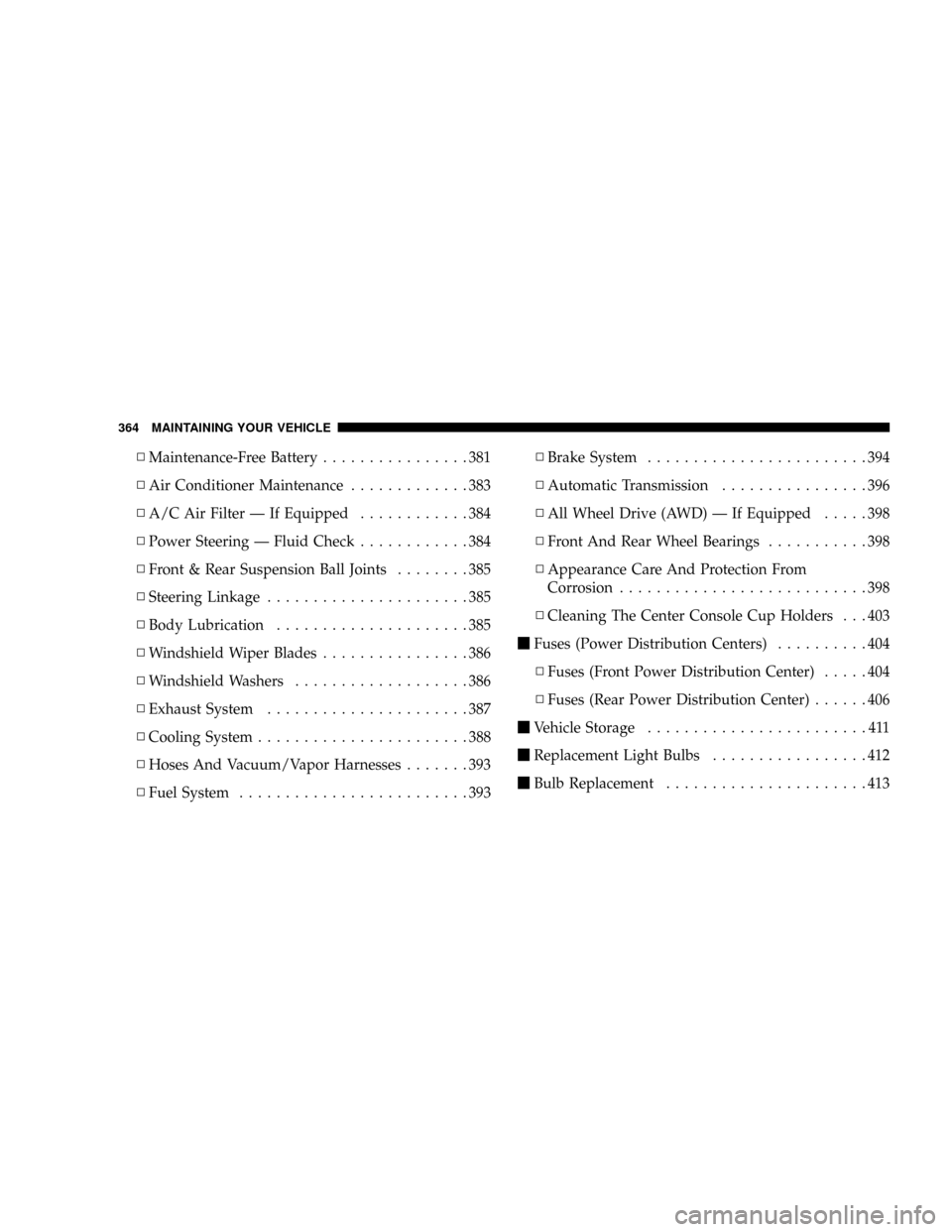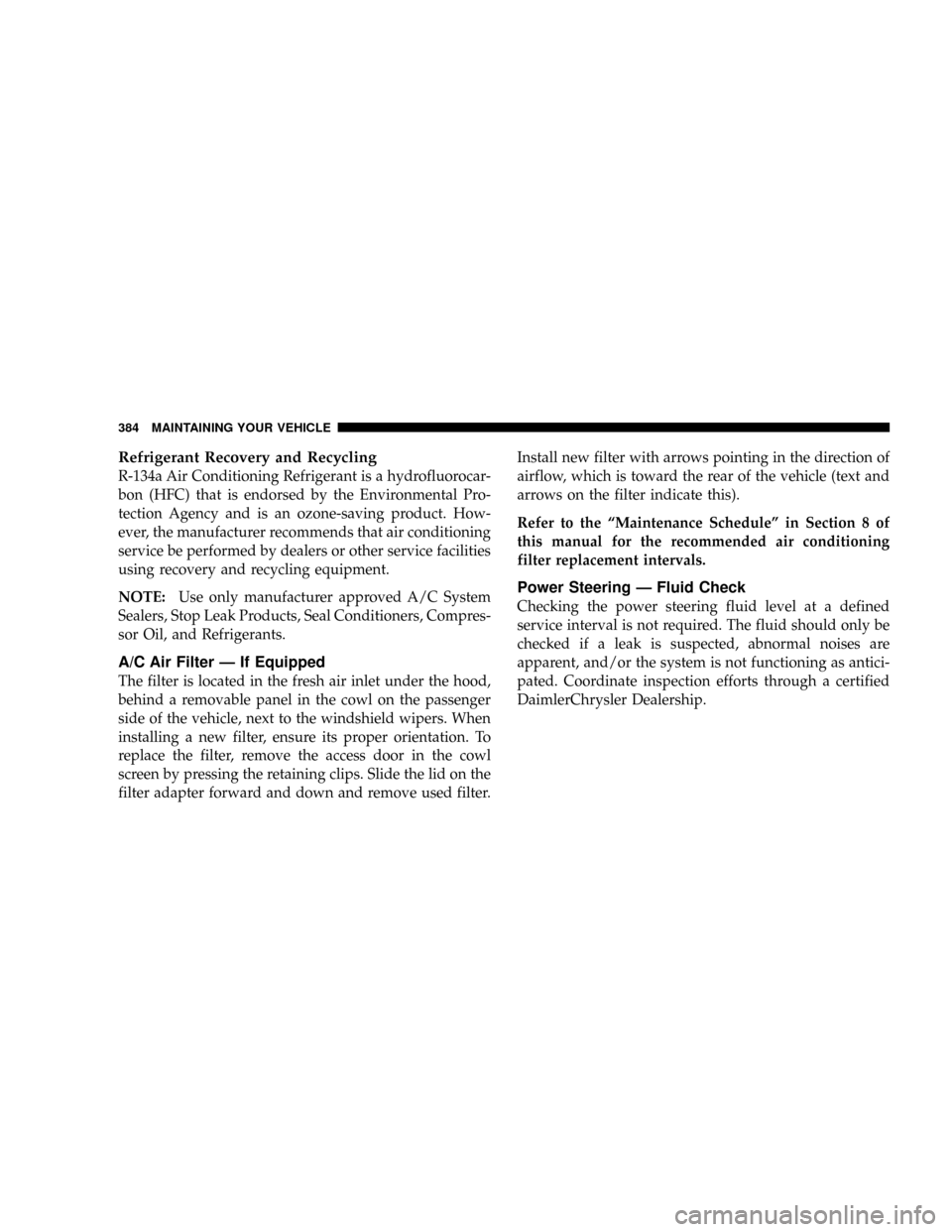Page 337 of 466

²When hauling cargo, or towing a trailer, do not
overload your vehicle or trailer. Overloading can cause
a loss of control, poor performance, or damage to
brakes, axle, engine, transmission, steering, suspen-
sion, chassis structure, or tires.
²Safety chains must always be used between your
vehicle and trailer. Always connect the chains to the
frame or hook retainers of the vehicle hitch. Cross the
chains under the trailer tongue and allow enough
slack for turning corners.
²Vehicles with trailers should not be parked on a grade.
When parking, apply the parking brake on the tow
vehicle. Put the tow vehicle automatic transmission in
P for Park. Always, block or9chock9the trailer wheels.
²GCWR must not be exceeded.
²Total weight must be distributed between the tow
vehicle and the trailer such that the following four
ratings are not exceeded:1. GVWR
2. GTW
3. GAWR
4. Tongue weight rating for the trailer hitch utilized
(This requirement may limit the ability to always
achieve the 10% to 15% range of tongue weight as a
percentage of total trailer weight).
Towing Requirements Ð Tires
þ
Do not attempt to tow a trailer while using a compact
spare tire.
þProper tire inflation pressures are essential to the safe
and satisfactory operation of your vehicle. Refer to
ªTires±General Informationº in this section for infor-
mation on tire pressures and for proper tire inflation
procedures.
STARTING AND OPERATING 337
5
Page 359 of 466

NOTE:For vehicles equipped with ESP, refer to9Syn-
chronizing ESP9under9Electronic Stability Program9in
Section 5 of this manual if the ESP/BAS light (in the
instrument cluster) remains on continuously after start-
ing the engine of the vehicle with the discharged battery.
8. When removing the jumper cables, reverse the above
sequence exactly. Be careful of the moving belts and fan.
WARNING!
Any procedure other than above could result in:
1. Personal injury caused by electrolyte squirting out
the battery vent;
2. Personal injury or property damage due to battery
explosion;
3. Damage to charging system of booster vehicle or
of immobilized vehicle.
FREEING A STUCK VEHICLE
If your vehicle becomes stuck in mud, sand, or snow, it
can often be moved by a rocking motion. Turn your
steering wheel right and left to clear the area around the
front wheels. Then shift back and forth between Reverse
and Drive. Usually the least accelerator pedal pressure to
maintain the rocking motion without spinning the
wheels is most effective.
NOTE:Turn off the Electronic Stability Program (ESP)
Ð if equipped, or Traction Control System (TCS) Ð if
equipped before rocking the vehicle. For details, refer to
ªElectronic Stability Programº or ªTraction Control Sys-
temº in this manual.
WHAT TO DO IN EMERGENCIES 359
6
Page 364 of 466

NMaintenance-Free Battery................381
NAir Conditioner Maintenance.............383
NA/C Air Filter Ð If Equipped............384
NPower Steering Ð Fluid Check............384
NFront & Rear Suspension Ball Joints........385
NSteering Linkage......................385
NBody Lubrication.....................385
NWindshield Wiper Blades................386
NWindshield Washers...................386
NExhaust System......................387
NCooling System.......................388
NHoses And Vacuum/Vapor Harnesses.......393
NFuel System.........................393NBrake System........................394
NAutomatic Transmission................396
NAll Wheel Drive (AWD) Ð If Equipped.....398
NFront And Rear Wheel Bearings...........398
NAppearance Care And Protection From
Corrosion...........................398
NCleaning The Center Console Cup Holders . . . 403
mFuses (Power Distribution Centers)..........404
NFuses (Front Power Distribution Center).....404
NFuses (Rear Power Distribution Center)......406
mVehicle Storage........................411
mReplacement Light Bulbs.................412
mBulb Replacement......................413
364 MAINTAINING YOUR VEHICLE
Page 366 of 466
2.7L ENGINE COMPARTMENT
1 Ð Fuses (Front Power Distribution Center) 6 Ð Air Cleaner Filter
2 Ð Engine Oil Dipstick 7 Ð Coolant Pressure Cap
3 Ð Brake Fluid Reservoir Access Cover 8 Ð Engine Oil Fill
4 Ð Coolant Bottle 9 Ð Remote Jump-Start Positive Battery Post
5 Ð Power Steering Fluid 10 Ð Washer Fluid Bottle 366 MAINTAINING YOUR VEHICLE
Page 367 of 466
3.5L ENGINE COMPARTMENT
1 Ð Fuses (Front Power Distribution Center) 6 Ð Coolant Bottle
2 Ð Air Cleaner Filter 7 Ð Engine Oil Fill
3 Ð Brake Fluid Reservoir Access Cover 8 Ð Engine Oil Dipstick
4 Ð Coolant Pressure Cap 9 Ð Washer Fluid Bottle
5 Ð Power Steering Fluid 10 Ð Remote Jump-Start Positive Battery PostMAINTAINING YOUR VEHICLE 367
7
Page 368 of 466
5.7L ENGINE COMPARTMENT Ð EXCEPT DAYTONA & R/T
1 Ð Fuses (Front Power Distribution Center) 6 Ð Air Cleaner Filter
2 Ð Coolant Pressure Cap 7 Ð Engine Oil Fill
3 Ð Brake Fluid Reservoir Access Cover 8 Ð Engine Oil Dipstick
4 Ð Coolant Bottle 9 Ð Remote Jump-Start Positive Battery Post
5 Ð Power Steering Fluid 10 Ð Washer Fluid Bottle 368 MAINTAINING YOUR VEHICLE
Page 369 of 466
5.7L ENGINE COMPARTMENT Ð DAYTONA & R/T
1 Ð Fuses (Front Power Distribution Center) 6 Ð Air Cleaner Filter
2 Ð Coolant Pressure Cap 7 Ð Engine Oil Fill
3 Ð Brake Fluid Reservoir Access Cover 8 Ð Engine Oil Dipstick
4 Ð Coolant Bottle 9 Ð Remote Jump-Start Positive Battery Post
5 Ð Power Steering Fluid 10 Ð Washer Fluid BottleMAINTAINING YOUR VEHICLE 369
7
Page 384 of 466

Refrigerant Recovery and Recycling
R-134a Air Conditioning Refrigerant is a hydrofluorocar-
bon (HFC) that is endorsed by the Environmental Pro-
tection Agency and is an ozone-saving product. How-
ever, the manufacturer recommends that air conditioning
service be performed by dealers or other service facilities
using recovery and recycling equipment.
NOTE:Use only manufacturer approved A/C System
Sealers, Stop Leak Products, Seal Conditioners, Compres-
sor Oil, and Refrigerants.
A/C Air Filter Ð If Equipped
The filter is located in the fresh air inlet under the hood,
behind a removable panel in the cowl on the passenger
side of the vehicle, next to the windshield wipers. When
installing a new filter, ensure its proper orientation. To
replace the filter, remove the access door in the cowl
screen by pressing the retaining clips. Slide the lid on the
filter adapter forward and down and remove used filter.Install new filter with arrows pointing in the direction of
airflow, which is toward the rear of the vehicle (text and
arrows on the filter indicate this).
Refer to the ªMaintenance Scheduleº in Section 8 of
this manual for the recommended air conditioning
filter replacement intervals.
Power Steering Ð Fluid Check
Checking the power steering fluid level at a defined
service interval is not required. The fluid should only be
checked if a leak is suspected, abnormal noises are
apparent, and/or the system is not functioning as antici-
pated. Coordinate inspection efforts through a certified
DaimlerChrysler Dealership.
384 MAINTAINING YOUR VEHICLE